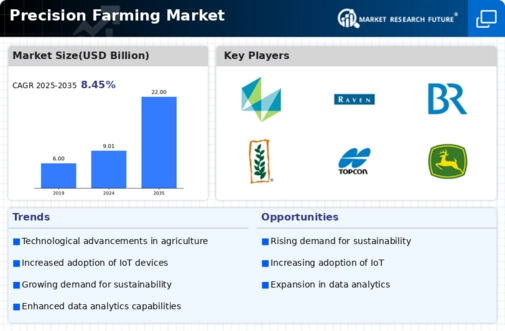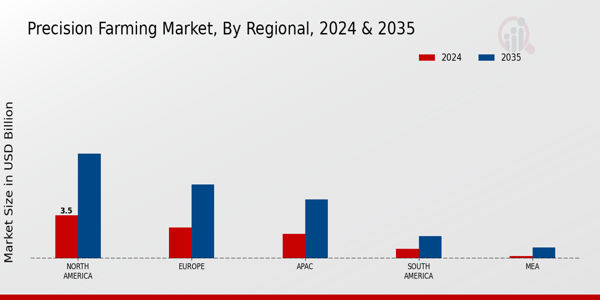Technological Advancements
The Global Precision Farming Market Industry is experiencing rapid technological advancements, which are reshaping agricultural practices. Innovations such as drones, IoT devices, and AI-driven analytics are enhancing crop monitoring and management. For instance, the integration of satellite imagery and real-time data analytics allows farmers to make informed decisions regarding irrigation and fertilization. This technological evolution is projected to contribute significantly to the market's growth, with the industry expected to reach 9.01 USD Billion in 2024 and further expand to 22 USD Billion by 2035, reflecting a compound annual growth rate (CAGR) of 8.45% from 2025 to 2035.
Rising Adoption of Data Analytics
The rising adoption of data analytics in agriculture is significantly impacting the Global Precision Farming Market Industry. Farmers are increasingly utilizing data-driven insights to enhance decision-making processes related to crop management and resource allocation. The integration of big data analytics allows for precise forecasting and risk assessment, which can lead to improved yields and reduced costs. This trend is expected to contribute to the market's expansion, with projections indicating a growth from 9.01 USD Billion in 2024 to 22 USD Billion by 2035, supported by a CAGR of 8.45% from 2025 to 2035.
Government Initiatives and Support
Government initiatives aimed at promoting sustainable agriculture are playing a pivotal role in the Global Precision Farming Market Industry. Various countries are implementing policies that encourage the adoption of precision farming technologies through subsidies and grants. For example, programs that provide financial assistance for purchasing advanced farming equipment are becoming more prevalent. These initiatives not only support farmers in adopting innovative practices but also contribute to environmental sustainability. As a result, the market is expected to grow significantly, with projections indicating a rise from 9.01 USD Billion in 2024 to 22 USD Billion by 2035.
Increasing Demand for Food Security
As the global population continues to rise, the demand for food security intensifies, driving the Global Precision Farming Market Industry. Precision farming techniques enable farmers to maximize yield while minimizing resource usage, which is crucial in meeting the nutritional needs of an expanding population. The ability to produce more food with less land and water is becoming increasingly vital. This trend is likely to propel the market forward, as stakeholders recognize the importance of sustainable farming practices. The industry's growth is supported by the anticipated increase in market value from 9.01 USD Billion in 2024 to 22 USD Billion by 2035.
Environmental Sustainability Concerns
Growing concerns regarding environmental sustainability are influencing the Global Precision Farming Market Industry. Farmers are increasingly aware of the ecological impact of traditional farming practices, leading to a shift towards precision agriculture. This approach minimizes chemical usage and optimizes resource allocation, thereby reducing the carbon footprint of agricultural activities. The emphasis on sustainable practices is likely to drive market growth, as consumers and regulatory bodies demand more environmentally friendly solutions. The industry's value is projected to increase from 9.01 USD Billion in 2024 to 22 USD Billion by 2035, reflecting a broader commitment to sustainability.


















Leave a Comment